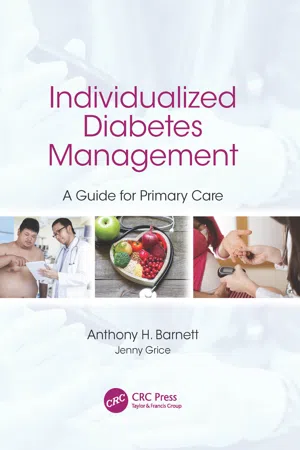
- 116 pages
- English
- ePUB (mobile friendly)
- Available on iOS & Android
About this book
In the past few decades a revolution in our approach to treating type 2 diabetes has occurred following the recognition that the condition is caused by multiple defects. A range of new treatments are now available, with many more forthcoming, utilising differing mechanisms of action that allow targeted and more effective therapy of this multifactorial disease than ever before.
The increasing requirement in the UK to move much of diabetes practice into the community requires much more detailed knowledge of the condition by GPs and practice nurses. In this bespoke book, the authors aim to show how new mechanisms of glucose control and advances in treatments arising from this can tailor treatment to the individual in primary care. This book incorporates the recently published ADA/EASD guidelines and the 2015 update from the National Institute for Health and Clinical Excellence (NICE).
Essential reading for the multi-professional diabetes care team, this book should also be of interest to hospital specialists in training.
Frequently asked questions
- Essential is ideal for learners and professionals who enjoy exploring a wide range of subjects. Access the Essential Library with 800,000+ trusted titles and best-sellers across business, personal growth, and the humanities. Includes unlimited reading time and Standard Read Aloud voice.
- Complete: Perfect for advanced learners and researchers needing full, unrestricted access. Unlock 1.4M+ books across hundreds of subjects, including academic and specialized titles. The Complete Plan also includes advanced features like Premium Read Aloud and Research Assistant.
Please note we cannot support devices running on iOS 13 and Android 7 or earlier. Learn more about using the app.
Information
Table of contents
- Cover
- Half Title
- Title Page
- Copyright Page
- Contents
- Biography
- Introduction
- 1 Type 2 diabetes: epidemiology, complications and costs
- 2 Challenges to glycaemic control
- 3 Barriers to adherence and their solutions
- 4 Advantages and disadvantages of new therapies
- 5 New insulin developments
- 6 Personalised management
- 7 Organisation of diabetes care
- Index